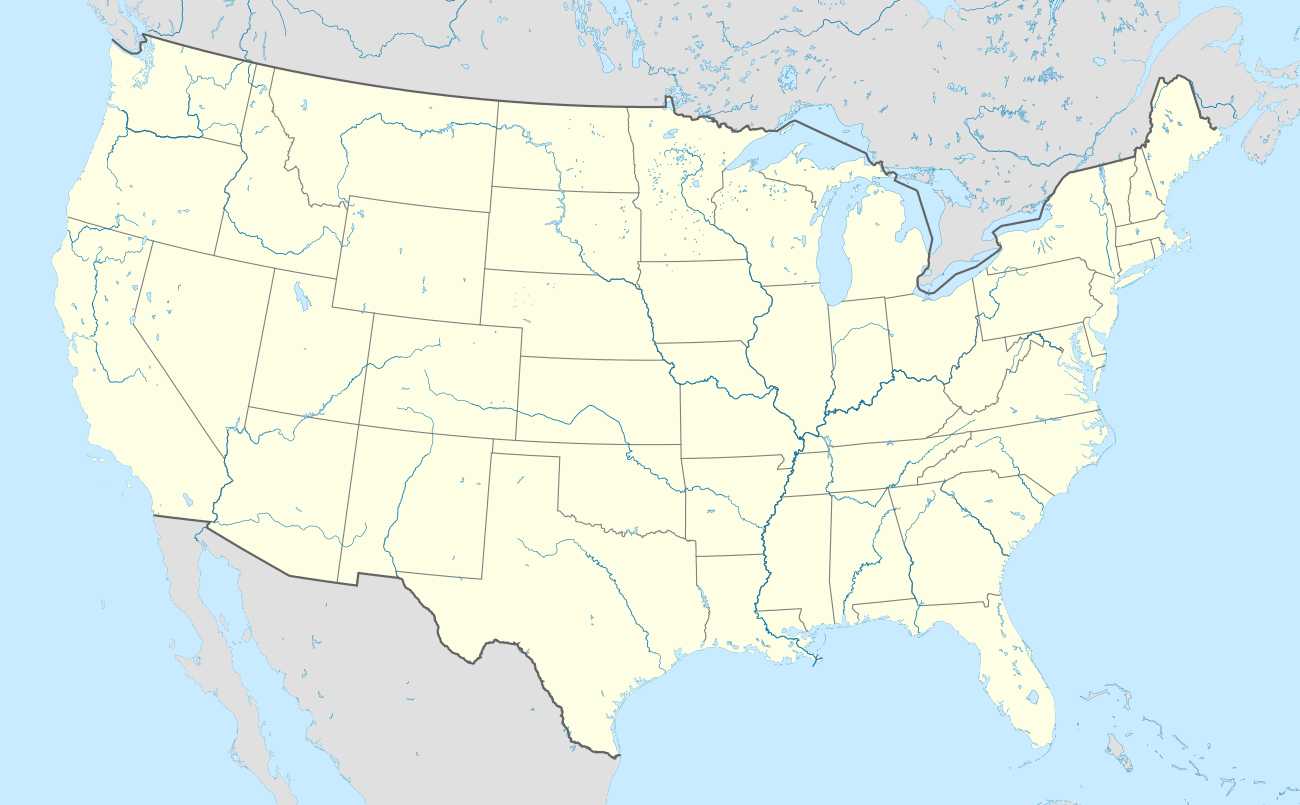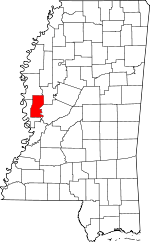Rolling Fork, Mississippi
Rolling Fork is a town in Sharkey County, Mississippi.[3] The population was 2,143 at the 2010 census. It is the county seat of Sharkey County.[4]
Rolling Fork, Mississippi | |
|---|---|
 Sharkey County Courthouse in Rolling Fork | |
 Location of Rolling Fork, Mississippi | |
 Rolling Fork, Mississippi Location in the United States | |
| Coordinates: 32°54′23″N 90°52′41″W | |
| Country | United States |
| State | Mississippi |
| County | Sharkey |
| Area | |
| • Total | 1.41 sq mi (3.66 km2) |
| • Land | 1.41 sq mi (3.66 km2) |
| • Water | 0.00 sq mi (0.00 km2) |
| Elevation | 105 ft (32 m) |
| Population (2010) | |
| • Total | 2,143 |
| • Estimate (2018)[2] | 1,945 |
| • Density | 1,393.06/sq mi (538.04/km2) |
| Time zone | UTC-6 (Central (CST)) |
| • Summer (DST) | UTC-5 (CDT) |
| ZIP code | 39159 |
| Area code(s) | 662 |
| FIPS code | 28-63560 |
| GNIS feature ID | 694602[3] |
History

Thomas Y. Chaney located here in 1828, and was the first settler in the county. Deer Creek flows through the settlement, and Chaney called the place "Rolling Fork" because of the swiftness of the water at a fork in the creek there.[5]
A post office was established in 1848.[5]
When Sharkey County was established in 1876, Rolling Fork was made the county seat.[5]
A newspaper, The Deer Creek Pilot, was established in 1884.[5]
The Louisville, New Orleans and Texas Railway was built through Rolling Fork in 1883.[5] It was later acquired by the Illinois Central Railroad.
In 1908, the Bank of Rolling Fork was established.[5]
Rolling Fork had a population of 1,000 in 1906.[5]
Geography
According to the United States Census Bureau, the city has a total area of 1.4 square miles (3.6 km2), all land.
Demographics
| Historical population | |||
|---|---|---|---|
| Census | Pop. | %± | |
| 1880 | 91 | — | |
| 1920 | 703 | — | |
| 1930 | 902 | 28.3% | |
| 1940 | 1,320 | 46.3% | |
| 1950 | 1,229 | −6.9% | |
| 1960 | 1,619 | 31.7% | |
| 1970 | 2,034 | 25.6% | |
| 1980 | 2,590 | 27.3% | |
| 1990 | 2,444 | −5.6% | |
| 2000 | 2,486 | 1.7% | |
| 2010 | 2,143 | −13.8% | |
| Est. 2018 | 1,945 | [2] | −9.2% |
| U.S. Decennial Census[6] | |||

At the 2000 census there were 2,486 people in 820 households, including 620 families, in the city. The population density was 1,774.2 people per square mile (685.6/km²). There were 875 housing units at an average density of 624.5 per square mile (241.3/km²). The racial makeup of the city was 69.19% African American, 29.69% White, 0.04% Native American, 0.32% Asian, and 0.76% from two or more races. Hispanic or Latino of any race were 0.97%.[7]
Of the 820 households 35.9% had children under the age of 18 living with them, 37.9% were married couples living together, 32.8% had a female householder with no husband present, and 24.3% were non-families. 22.2% of households were one person and 9.5% were one person aged 65 or older. The average household size was 2.90 and the average family size was 3.40.
The age distribution was 30.8% under the age of 18, 11.9% from 18 to 24, 23.8% from 25 to 44, 20.4% from 45 to 64, and 13.2% 65 or older. The median age was 32 years. For every 100 females, there were 83.6 males. For every 100 females age 18 and over, there were 75.4 males.
The median household income was $23,081 and the median family income was $24,911. Males had a median income of $25,729 versus $17,065 for females. The per capita income for the city was $11,481. About 30.6% of families and 37.1% of the population were below the poverty line, including 50.0% of those under age 18 and 24.6% of those age 65 or over.
Education
Public schools
The city of Rolling Fork is served by the South Delta School District. The district has three schools with a total enrollment of approximately 1,300 students.
Private schools
Notable people
- Tommy Davidson, actor and professional comedian
- Jack Holmes, professional football player
- Larry Smith, professional basketball player
- Willie Mae Ford Smith, gospel singer
- Slick Watts, professional basketball player
- Fielding L. Wright, Governor of Mississippi and 1948 vice-presidential candidate
References
- "2017 U.S. Gazetteer Files". United States Census Bureau. Retrieved Jan 6, 2019.
- "Population and Housing Unit Estimates". Retrieved December 20, 2019.
- U.S. Geological Survey Geographic Names Information System: Rolling Fork
- "Find a County". National Association of Counties. Retrieved 2011-06-07.
- Rowland, Dunbar (1907). Mississippi: Comprising Sketches of Counties, Towns, Events, Institutions, and Persons, Arranged in Cyclopedic Form. 2. Southern Historical Publishing Association. p. 575.
- "Census of Population and Housing". Census.gov. Retrieved June 4, 2015.
- "U.S. Census website". United States Census Bureau. Retrieved 2008-01-31.
